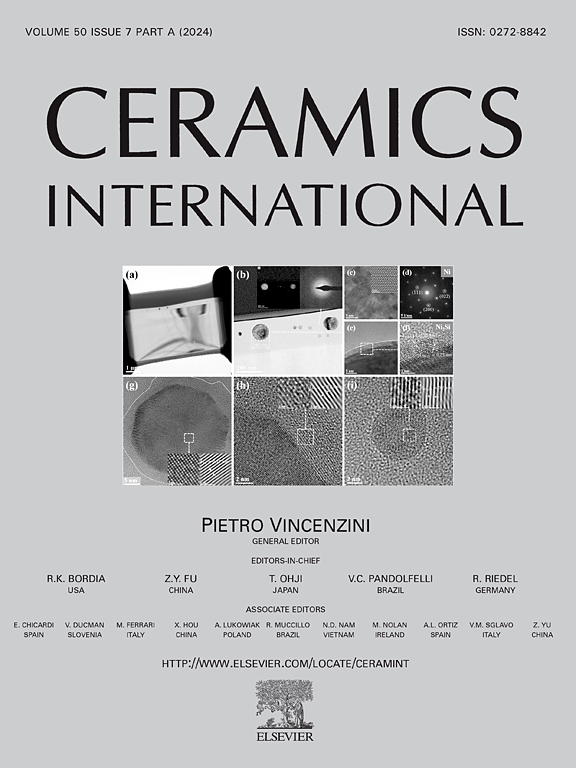HA和LaB6对激光直接能量沉积Ti6Al4V合金生物摩擦学性能的协同改善
IF 5.6
2区 材料科学
Q1 MATERIALS SCIENCE, CERAMICS
引用次数: 0
摘要
本研究引入稀土硼化物(LaB6)和生物活性陶瓷(HA),以提高激光直接能量沉积(ld)法制备Ti6Al4V合金的生物摩擦学性能。采用光学显微镜(OM)、扫描电镜(SEM)、x射线衍射仪(XRD)、能谱仪(EDS)、维氏硬度计、UMT-3摩擦计等方法和仪器对材料的微观结构、相组成、显微硬度和生物摩擦学性能进行了研究。结果表明:原位反应形成La2O3和网状TiBw,且La2O3在晶界处的分布有利于晶粒的齐纳钉钉细化;然而,HA的加入削弱了晶粒细化的效果。此外,由于P元素对β-Ti和大晶粒形成的促进作用,显微硬度没有明显变化。此外,在磷酸盐缓冲盐水(PBS)环境下,磨损表面形成含磷酸盐的摩擦膜,导致生物摩擦学性能显著改善。本研究为Ti6Al4V在骨科植入物中的进一步应用提供了有价值的见解。本文章由计算机程序翻译,如有差异,请以英文原文为准。
Synergistic improvement of HA and LaB6 on the bio-tribological properties of Ti6Al4V alloy fabricated by laser direct energy deposition
This study introduced rare earth boride (LaB6) and bioactive ceramic (HA) to enhance the bio-tribological properties of Ti6Al4V alloy fabricated by laser direct energy deposition (LDED). The methods and instruments such as optical microscope (OM), scanning electron microscopy (SEM), X-ray diffraction (XRD), energy dispersive spectrometry (EDS), Vickers hardness tester, and UMT-3 tribometer were employed to examine the microstructure, phase composition, microhardness, and bio-tribological properties. The results showed that the La2O3 and network-like TiBw formed through in-situ reactions, and the distribution of La2O3 at the grain boundaries facilitated grain refinement through Zener pinning; Yet, the addition of HA weakened the effect of grain refinement. Besides, the microhardness was not significantly changed due to the promoting effect of P element on the formation of β-Ti and large grains. Furthermore, under the phosphate buffered saline (PBS) environment, a tribofilm containing phosphate on the worn surface formed, leading to a remarkable improvement in the bio-tribological properties. This study provides valuable insights for the further application of Ti6Al4V in orthopedic implants.
求助全文
通过发布文献求助,成功后即可免费获取论文全文。
去求助
来源期刊

Ceramics International
工程技术-材料科学:硅酸盐
CiteScore
9.40
自引率
15.40%
发文量
4558
审稿时长
25 days
期刊介绍:
Ceramics International covers the science of advanced ceramic materials. The journal encourages contributions that demonstrate how an understanding of the basic chemical and physical phenomena may direct materials design and stimulate ideas for new or improved processing techniques, in order to obtain materials with desired structural features and properties.
Ceramics International covers oxide and non-oxide ceramics, functional glasses, glass ceramics, amorphous inorganic non-metallic materials (and their combinations with metal and organic materials), in the form of particulates, dense or porous bodies, thin/thick films and laminated, graded and composite structures. Process related topics such as ceramic-ceramic joints or joining ceramics with dissimilar materials, as well as surface finishing and conditioning are also covered. Besides traditional processing techniques, manufacturing routes of interest include innovative procedures benefiting from externally applied stresses, electromagnetic fields and energetic beams, as well as top-down and self-assembly nanotechnology approaches. In addition, the journal welcomes submissions on bio-inspired and bio-enabled materials designs, experimentally validated multi scale modelling and simulation for materials design, and the use of the most advanced chemical and physical characterization techniques of structure, properties and behaviour.
Technologically relevant low-dimensional systems are a particular focus of Ceramics International. These include 0, 1 and 2-D nanomaterials (also covering CNTs, graphene and related materials, and diamond-like carbons), their nanocomposites, as well as nano-hybrids and hierarchical multifunctional nanostructures that might integrate molecular, biological and electronic components.
 求助内容:
求助内容: 应助结果提醒方式:
应助结果提醒方式:


